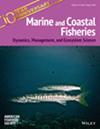Perspective comes with time: What do long-term egg and juvenile indices say about Chesapeake Bay Striped Bass productivity?
Abstract
Objective
Three hypotheses about poor recruitment and collapse of Striped Bass Morone saxatilis in Chesapeake Bay during the 1970s and 1980s (excessive larval mortality related to water quality, recruitment overfishing, or a combination) emerged from intense investigations during the mid-1980s into the early 1990s. Stock collapse during the 1970s and 1980s and recovery in 1995 were largely attributed to fishing mortality and this premise largely drives management. Stock and larval habitat assessments were not available before the early 1980s and habitat assessments were discontinued after recovery. I used egg and juvenile index time-series that extended back to 1955 to test these three hypotheses about changes in productivity.
Methods
Long-term (1955–2019) indices of recruitment (juvenile index [JI]), spawning dispersion in time and space (Ep, proportion of plankton net samples with eggs), and an index of relative larval survival (RLS = JI/Ep) for spawning areas in Maryland’s portion of Chesapeake Bay were used to investigate whether larval survival patterns were stable (supported the overfishing hypothesis) or changed (supported the larval mortality hypothesis).
Result
Baywide Ep estimates were within similar higher ranges during 1957–1981 and 1989–2019, and were low enough to affect recruitment during 1982–1988. While there was a strong relationship of baywide Ep to spawning stock biomass (SSB) estimated by the stock assessment during recovery (1982–1995), estimates of Ep went from depleted to a high level earlier than SSB estimates. Estimates of postrecovery Ep and SSB were both high, but did not have a relationship. A decline in SSB that began in 2012 was not evident with Ep. A shift to low JIs in the early 1970s was followed by a decline in baywide Ep after 1979. Estimates of RLS were higher in 1960s, declined in the early to mid-1970s, were mostly low into the early 1990s, and became higher afterward. Recovery of Ep after 1988 was accompanied by recovery of larval survival a few years later. Strong correlations of juvenile indices of Striped Bass, White Perch Morone americana, and Yellow Perch Perca flavescens further supported the larval survival hypothesis; these anadromous fish share larval nurseries in space and time, but have different life histories and fisheries that make simultaneous overfishing unlikely.
Conclusion
Deterioration of larval survival initiated the collapse of Chesapeake Bay Striped Bass and improvement contributed to recovery. The hypothesis that collapse and recovery was solely driven by fishing was not supported, but excessive fishing pressure lowered Ep and SSB and contributed to poor recruitment during 1982–1988. Long-term climate patterns and warming, deterioration and improvement in acidic deposition, concurrent increases in freshwater salinization and alkalinization, and shifts in agriculture and watershed management indicated shifts in larval habitat suitability were plausible.


 求助内容:
求助内容: 应助结果提醒方式:
应助结果提醒方式:


